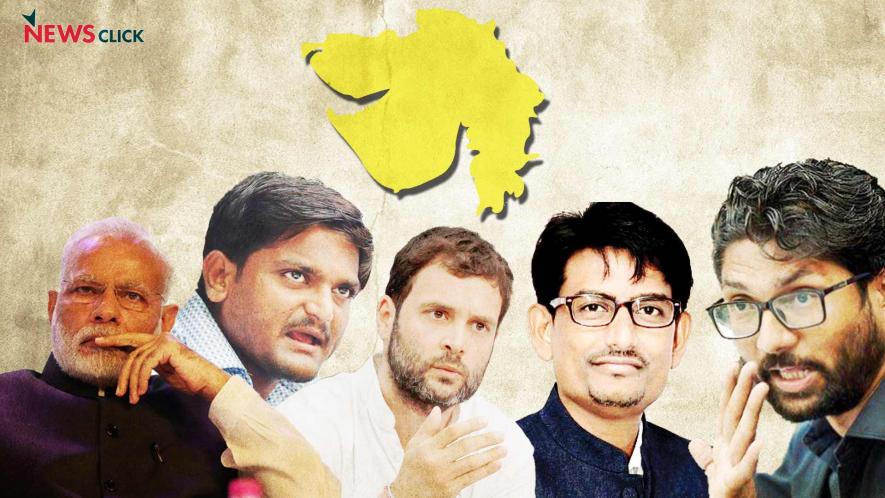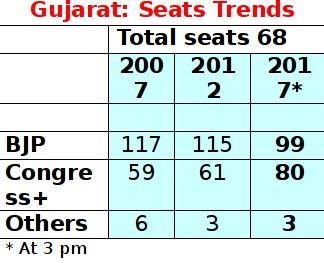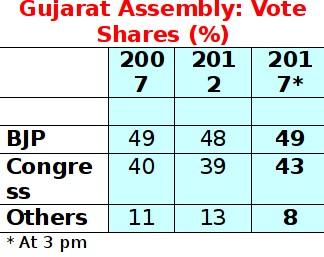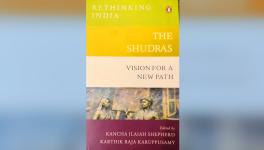Gujarat Results: Modi & BJP Scrape Through With Thin Majority

Newsclick Image by Trina Shankar
The ruling BJP has scraped through with a majority in the Gujarat Assembly, getting (or leading) in 99 seats out of 182. The Congress and its allies have won (or are leading in) 80 seats, with others pegged at 3 seats. These are declared wins plus leadings at about 3 pm, with final results expected by 6 pm.
The BJP, despite Prime Minister Modi’s desperate campaigning, announcements of over Rs.20,000 crore worth of programmes and schemes, and reported recourse to religious appeals and pseudo-nationalist rhetoric, has ended up with a much reduced tally in the Assembly. They had won 115 seats in the last elections in 2012, and added 6 more in various bye-elections. So they have actually slid from 122 down to 101, a loss of 21 seats. Congress, on the other hand has increased its strength from 61 in 2012 (down to 55 due to losses in bye-elections) to 79 this time round. This includes two MLAs of the Bharat Tribal Party which fought the election in alliance with Congress and one independent (dalit leader Jignesh Mevani) who was supported by Congress.

Although final vote shares are awaited as counting is still in progress, BJP has managed about 49% vote share slightly more than 2012 but about the same if subsequent bye-election victories are included. Congress on the other hand has improved its support from 39% last time to 43% this time. Independents and others have been squeezed out in this heavy duty battle ending up with 8% votes compared to 13% last time.

Considering that this election was virtually fought by Modi himself, assisted by BJP president Amit Shah, the BJP ‘victory’ is a big blow to the PM’s credibility and his party’s governance record, both at the Centre and at the state level.
The so called Gujarat model – high growth, big corporate profits, low workers wages, gross neglect of farmers to benefit urban and metropolitan capital, funds cuts and disarray of health, education and social welfare programmes – had left large sections of the Gujarati people in dire distress. Gujarat also has been the crucible in which Hindutva was used to ‘unite’ the majority community against minorities, dalits and tribals, and mobilize this support to legitimize and perpetuate BJP’s political rule. This election has seen the cracking up of all this.
The people’s anger with the ruling dispensation found expression in challenges to the BJP’s intertwined economic policy and its Hindutva strategy. Farmers’ distress at indebtedness, diminishing incomes, land acquisitions and continued neglect by the ruling BJP broke out in the form of protests by Patidars demanding reservations in jobs, and the snowballing of this in to other castes too demanding attention. Dalit communities too rallied against the BJP angered at their distressful economic condition and the govt’s. silence over atrocities by upper castes. Tribals, in turn, were agitated by joblessness and neglect. All this broke the majoritarian ‘unity’ that had been sustaining the BJP.
Political advantage of this crumbling base was sought to be taken by the only viable opposition in the state, the Congress. Led by Rahul Gandhi, it too campaigned heavily, struck caste based alliances, promised all kinds of things to all sections and generally propelled the battle into the neck to neck zone.
However, this pitched battle has also brought to fore the principal problem enveloping Indian politics today. Does the Congress have the organization, the ideology and the credibility to beat BJP? Gujarat points to the failings of Congress as much as it does to those of the BJP. The rising tide of anger at the BJP’s pro-corporate juggernaut could not be consolidated and turned into a weapon by Congress to demolish the BJP. At the ground level, people were visibly angry – but they were not sure whether the Congress could deliver the goods. One of the main reasons for this is that the Congress, as people well know, espouses the same economic agenda as that of the BJP. People have seen and suffered it for years.
This has led to several consequences. Voter turnout dropped by about 4 percentage points compared to the last election, indicating disillusionment with choices on offer. More importantly, it contributed to the survival of BJP by the skin of its teeth. Caste politics has its downside – several other castes were rallied towards the BJP. This would not have been the case if, say, a united farmers’ movement had been opposing the BJP because their distress cut across caste lines.
The Gujarat election is over, but it has very important lessons to offer for the country. BJP is losing its sheen, especially in rural areas. This will have more pronounced effects in other states where rural population share is more than in Gujarat. Other sections, like industrial workers, informal sector workers, agricultural labourers etc. are reeling under the twin onslaught og stagnating wages and rising prices. Joblessness has become endemic, with Modi offering no solution. Under these conditions, an opposition based on alternative economic policies and adhering to secular values presents a much more viable and potentially winnable option for the people.
Get the latest reports & analysis with people's perspective on Protests, movements & deep analytical videos, discussions of the current affairs in your Telegram app. Subscribe to NewsClick's Telegram channel & get Real-Time updates on stories, as they get published on our website.























